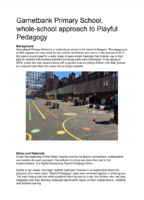The biggest barrier to Playful Pedagogy is often school systems and culture that were setup for a more traditional style of teaching and learning.
Common challenges or barriers teachers report are:
- The practicalities of managing a large class on open-ended activities, especially where there are diverse support needs.
- Preparing and resourcing suitable spaces and materials, alongside possible new paperwork burdens.
- Expectations and assumptions from management, colleagues, and parents about how children should be taught or assessed.
- Misconceptions about what play is, and the fundamental role it serves in formal learning.
Small steps can help you work towards addressing barriers. This begins with experimenting with Playful Pedagogy, and then reflecting upon how systems and culture can be reoriented and adapted without creating additional burdens.
Key elements of this include:
- Building and sharing knowledge of the “why” of playful pedagogy.
- Encouraging outdoor learning as this provides a motivating setting with a free supply of loose materials.
- Developing a suitable reporting and risk assessment framework which doesn’t put teachers off from trying.
- Exploring approaches to design and management that give teachers flexibility to support each other on the learning adventure.
- Planning collectively for bigger changes to ensure a one-team approach, with training and support needs identified.
Parents often have the strongest opinions about how their child should be educated. Therefore, you might want to build your playful pedagogical confidence, knowledge and experience before involving them directly in learning adventures. However, once you do, it may be the best way to convince them of its value.
Ways of bringing sceptical parents on the learning adventure might be:
- Directing them towards the weight of evidence and stakeholder support for the approach, and its relationship to attainment.
- Point out that countries which employ Playful Pedagogy, and don’t focus on formal literacy and numeracy until older years, generally perform better than the UK on both.
- Ask parents about how they learn best and use this as a starting point to explore the impact of choice, collaboration, and self-expression on their motivation.
- Stress your responsibility is not to individual pupils, but to the whole class. Playful Pedagogy is the best way of creating a one-team approach where no one gets left behind. The learning benefits for their child will become more and more apparent with time.
Overall, thinking about adapting the broader context is a learning adventure itself. It involves the whole school: management, pupils, teachers, and parents. It begins with small steps but engages everyone in reorienting school systems to enable and support best practice.
The case study below explores how one school integrated Playful Pedagogy across their approach. Meanwhile, the helpful resource from Highland Council reflects on teachers’ experiences and addresses many of the common barriers and ways they might be overcome.






